On the morning of January 20, 2018, I found myself roaming the back roads of Washington County, Tennessee with my camera and an itchy shutter finger. I had been in Kingsport for a week on business and was desperate to find something to write about in the area. It was by pure coincidence that I happened upon Gray Fossil Site and General Shale Natural History Museum.
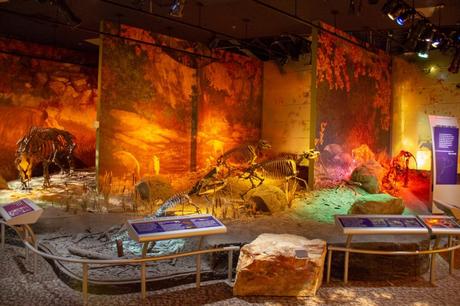 Dig Site
Dig Site
In May of 2000, a Tennessee DOT crew was grading an unsafe hill on State Route 75 in Gray, TN when they discovered something unusual. Fossils from several different animal species were found embedded in clay deposits just below the surface. The work stopped, and geologists were called in to investigate, leading Governor Don Sundquist to order the realignment of the street to protect what would prove to be an abundant accumulation of prehistoric animal remains. In 2007 East Tennessee University opened the Gray Fossil Site museum and research center.
East Tennessee University's Gray Fossil Site research lab. Researchers carefully examine all of the fossils unearthed at the dig sit in this room.
It was cold the morning that I happened to be driving by the facility and there was a lite dusting of snow on the ground. I walked into the museum and identified myself as a journalist to the young woman standing at a podium. I told her that I was interested in asking her some questions about the site and she immediately offered to introduce me to one of the researchers. While I waited, I wandered around the first-floor museum exhibits.
The MuseumThere where fossilized skeletons of extinct bears and alligators as well as other species that had been unearthed there over the last 18 years. Some of the equipment used to search for and analyze remains are on display in glass cases along the walls. I had just entered an area in the middle of the museum that contained a mock-up of a lab when a researcher named Davis approached and led me up a staircase to the actual research lab on the second floor.
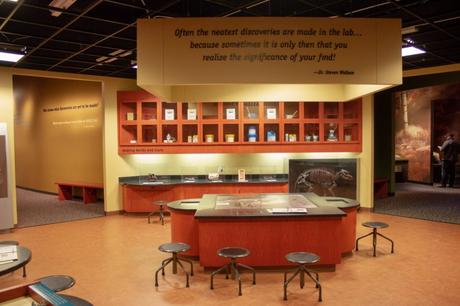
As a child, like most boys, I had a fascination with dinosaurs. I would inspect every rock on the ground for fossils and made my parents sit through every dinosaur movie that came out in the 1980s. My interest in prehistoric animals wained with age, but when I walked into that lab, I felt like I was ten years old again.
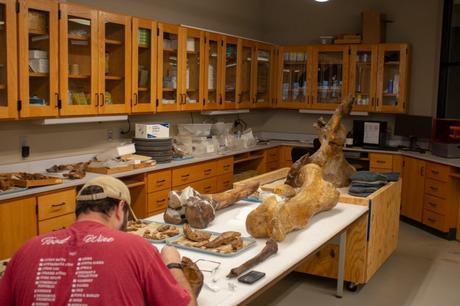
Volunteers were cleaning and analyzing petrified bones at large tables throughout the room. I hadn't thought of any questions since this was a spontaneous visit, but Davis' enthusiasm for the work made up for my lack of preparation. He walked me around the room, describing every relic in great detail. "This is from a Tapir." he said, pointing at a jagged piece of bone, "They're an extinct relative of the pig and the most common species we find here."
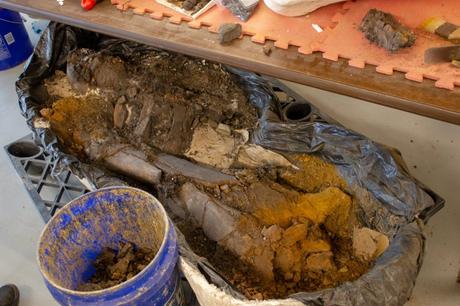
He opened some of the drawers on a large white cabinet and pointed out the remains of birds, snakes, lizards, and other small animals. I asked him how they identify the remains and he explained that Dr. Joshua X Samuels, a paleontologist with East Tennessee University, compares the fossilized bones and bone fragments with those of modern specimens. According to Davis, they use GPS coordinates to survey for fossils, and they screen all sediment in the area for even the smallest organisms.
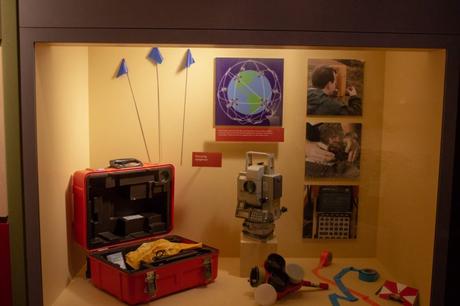
The rest of the staff seemed unphased by my presence as Davis continued to show me around the room. His already enthusiastic demeanor rose when we stopped at a table with what looked to me like a bag of dirt and debris. He outlined the shape of a large bone and identified it as a Mastodon's femur.
MastodonsThere was a giant sinkhole at what is now the dig site. Prehistoric animals would drink the water at the bottom of the hole, and larger mammals like mastodons would be unable to climb the loose dirt to get out. Since 2015, up to six of the massive creatures that perished in the sinkhole have been uncovered. Dr. Chris Widka, the Head Curator who studies the mastodons, predicts the last of them to be unearthed this year (2018).
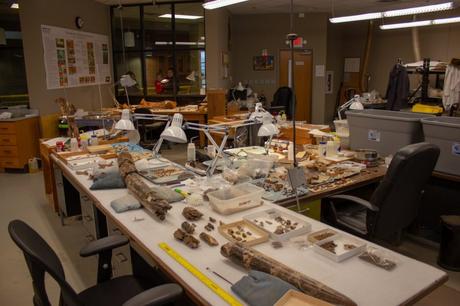
I ended the interview with a request to see the actual dig site. Unfortunately, as Davis pointed out through the window of the door that leads outside, the weather would not permit it. A blanket of snow had accumulated on the ground to the point where it wasn't safe or smart to explore, so I thanked my new friend, took a few more photographs, and left feeling lucky that I'd just happened to be driving by the Gray Fossil Site and General Shale Natural History Museum.

